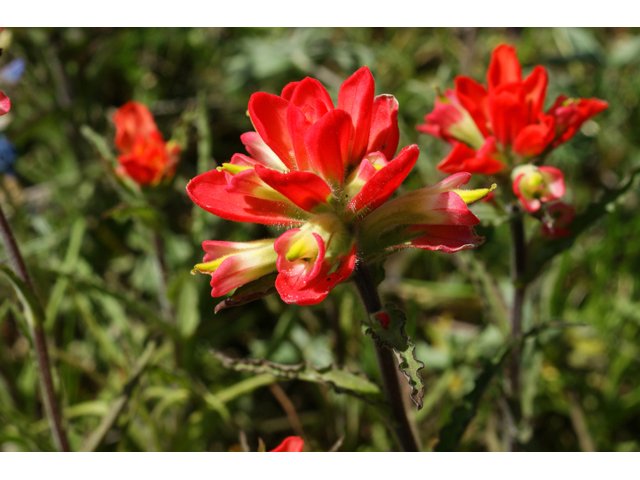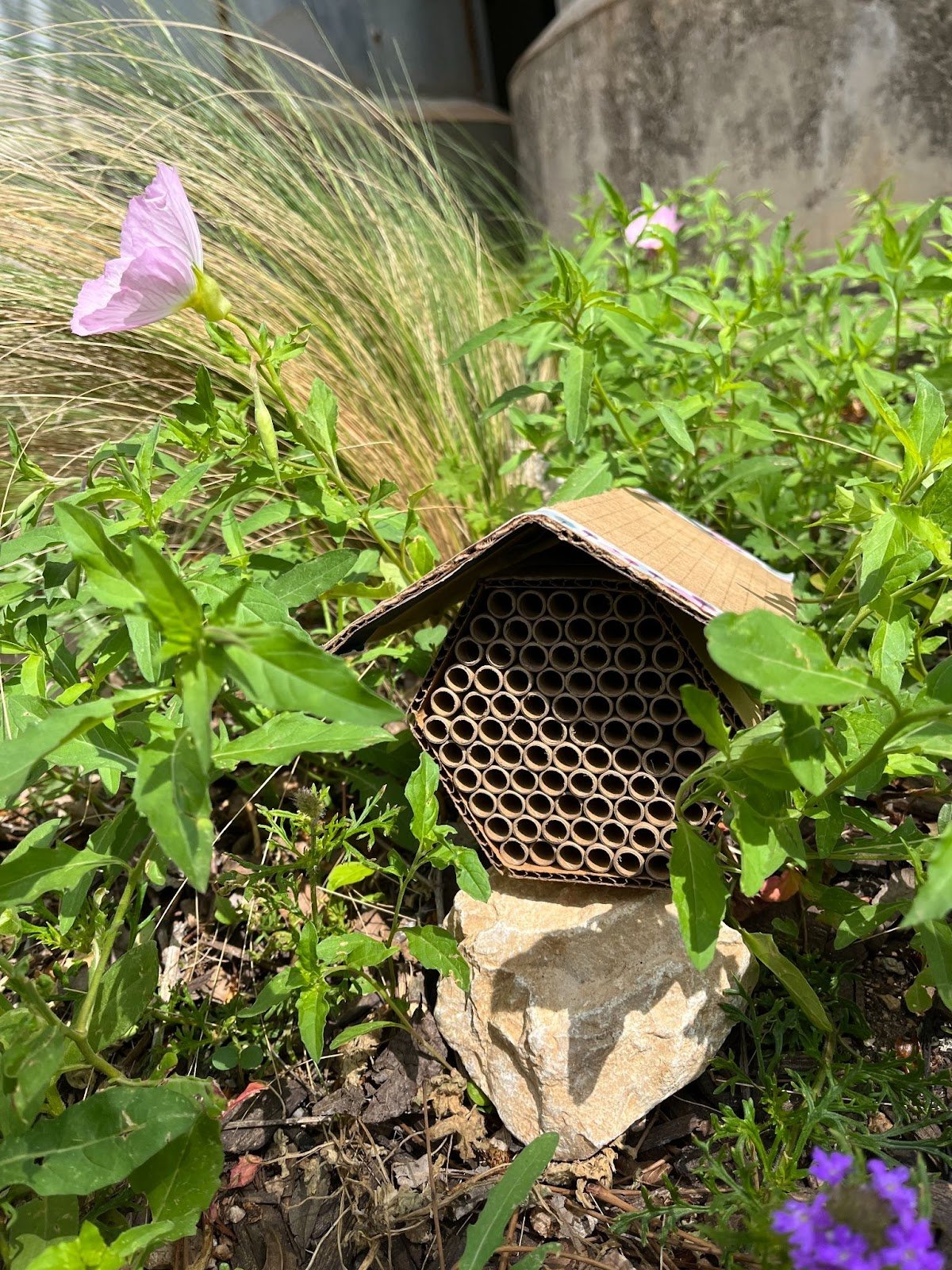The Science Mill is in bloom in the month of April. We are concentrating our efforts in our butterfly gardens and newly designed Food Forest to attract all varieties of 6 legged visitors to the museum. At the end of the month, we will host an awe-inspiring Pollinator Palooza event on Saturday, April 22nd where you and your family can participate in the pollination process.
-Amber Middlebrook, Director of Education Partnerships
This month’s blog covers the process of pollination, a brief history of taxonomy, an overview of the process of pollination, tools and resources to help you identify wildflowers and pollinators in your backyard, a fun take-home activity, and more!
Pollination is a crucial ecosystem service—a precious resource that requires attention and support—and is at increasing risk of disruption due to habitat loss, pesticide use and loss of biodiversity.
— Rachel Grotte M.S. Ecology and STEM Education Specialist for The Science Mill
Texas bluebonnet (Lupinus texensis)
It’s the season for being wowed by the explosion of wildflowers in the Texas Hill Country. With Bluebonnets, Texas Indian Paintbrush, Prairie Verbena and Firewheel popping up all along our highways, many Texans are thinking of ways to conserve and support wildflowers, as well as the pollinators that rely on them. Pollinating animals carry pollen on their bodies while they feed on plant nectar and pollen. This delivers genetic material between plants, allowing many plants that produce fruit, vegetables, and nuts to complete their life cycle. Bees, butterflies, beetles, birds, bats and other small animals that pollinate plants, are responsible for bringing us one out of every three bites of food. They sustain our ecosystems with this vital natural service, with a whopping value estimated at 5.4 billion dollars in agricultural productivity in the United States.
What’s in a Name? A Brief History of Taxonomy
“If the names are unknown knowledge of the things also perishes... For a single genus, a single name.”
—Carolus Linnaeus
Each wildflower and pollinator has a unique scientific name unlike any other. The system scientists use to name organisms is the Linnaean classification system of binomial nomenclature, named after its creator, Carolus Linnaeus. Linnaeus' gift to science was taxonomy: a classification system that standardizes the naming of species and orders them according to their characteristics and relationships with one another.
Each organism has two Latin names denoting genus and species; similar to the way that a name and surname identify each person. The groupings of organisms represent the evolutionary lineage of modern organisms from common ancestors.
Antelope horns milkweed (Asclepias asperula), is an important host plant for monarch caterpillars (Danaus plexippus). Can you spot the white, black and yellow caterpillar in the background?
You can learn the scientific names with field guides or with modern technology such as citizen science apps like E-Bird and iNaturalist or online databases and research tools like Iowa State University’s Bug Guide and the LBJ-Wildflower Center Database.
Who are the wildflowers and pollinators in your backyard?
With the help of technology, did you know you can easily identify flowers and pollinators with a photo?
Indian Paintbrush (Castilleja indivisa)
Monarch Butterfly (Danaus plexippus)
Download the app called iNaturalist to your phone. Take a picture of a wildflower, or an insect or other pollinator and watch as the software’s Artificial Intelligence matches your image to the millions in the database, and gives you its identity! Isn't technology amazing?
How can we help pollinators?
Plant native wildflowers in your yard. Many nurseries have a native section, or you can check a planting guide to see what is easy to find. Make sure you buy from nurseries that don’t spray with broad spectrum pesticides, or they can actually kill our pollinators! Perennials are a good idea if you want to plant a pollinator garden that comes back each year. Native flowers require less water and are naturally heat tolerant and pest resistant.
Build pitstops for butterflies and bees by putting out shallow dishes of water with stones or pebbles so the bees and butterflies can stop and have a drink.
Build a native bee home out of wood and paper. (See activity link below) There are hundreds of species of native solitary bees that are such important pollinators. The honey bee is actually an introduced species, and while its protection is also important, we should work hard at providing habitat for our native species as well.
Other methods: wood piles, leave the leaves (in fall), don’t spray pesticides, use IPM or biocontrol, xeriscape or increase biodiversity with less grass and more native flowers and trees.
Horsemint (Monarda citriodora)
European Honey Bee (Apis mellifera)
Get Involved! 2023 City Nature Challenge: Texas
From April 28, 2023 - May 1, 2023 Texas will join over 400 global cities for the City Nature Challenge, an annual competition to observe and record plant, fungi and wildlife species at your home, school or a local or state park!
Participating in the City Nature Challenge is easy:
From April 28, 2023 – May 1, 2023, find wildlife or plants in your community—or even in your own backyard.
Take a picture!
Join a project near you, and share your observations through iNaturalist, an app that allows community members to record what they see in nature and interact with other nature enthusiasts.
Not sure how to start? Drop by the Science Mill on April 28 and participate in the City Nature Challenge with us! We’ll help you learn the tools you’ll need to showcase the natural beauty of Texas!
White-lined Sphinx moth (Hyles lineata)
Don’t have time for the City Nature Challenge but still want to do a Bioblitz? Watch this video from NatGeo that walks you through a DIY version. You can also just contribute observations to iNaturalist or Seek on your own time. Making and identifying observations are by far the most important part.
Take-home Activity
Build A Mason Bee Home
Cut a 6”x 12” piece of sturdy corrugated cardboard, with the corrugation running along the 6” side. Take a sharp pair of scissors and score along the corrugation every 2” along until you have 6 sections. Bend the corrugated seams so that the entire piece of cardboard can be folded into a hexagonal tube.
Stuff the box with small cardboard tubes like these or rolled brown paper.
Add a pointed roof to keep water from collecting on the top. Add packing tape to the top to make it more water resistant. Tape into place.
Place your bug home in your backyard, somewhere out of the rain like in the eaves of a covered patio. (The images below are for fun. You should place yours in a protected yet accessible area)
Optional: If you want to make this design sturdier and weatherproof, build it with pieces of lumber.
Native solitary bees like Mason bees will move in and enjoy having a safe space to rest. Some bees may even use the tubes to lay their eggs. Make sure to check your bug home regularly and discard any pieces that become soggy or moldy. Want to make a more permanent version to help native bees? Read this guide to helping native bees in Texas.
Career Spotlight: Citizen Science
This month our career spotlight is a little different. Rather than tell the story of one STEM professional, we are focusing on a discipline of scientific work called Citizen Science. This is when everyday citizens, or those who are not professionally employed to do scientific work, contribute to a body of research with their observations of natural phenomena in the field or via virtual tools like wildlife cams or analysis tools. These sorts of contributions can be everything from scanning telescope images for celestial objects or identifying animals and plants from every habitat, to determining how a complex protein folds itself inside a cell or mapping the outbreak of a disease.
Many scientists have had to rely on these sorts of observations more heavily post Covid-19 outbreak. The ability to travel, meet in teams or complete field work was made more complex or in some cases, was impossible. One successful use of Citizen Science Data is water quality data collected by individuals, schools and naturalist groups across the US. Data is collected according to strict standards and contributed via portals such as Save Our Streams or Texas Stream Team. This data allows us to identify pollution situations earlier and helps us to identify “pristine” environments which should be protected and conserved. You can get involved in Citizen Science by finding local projects on SciStarter, or by participating in online projects using tools like iNaturalist and Zooniverse.
Resources:
Wildflower Resources:
Texas Wildflower Central-LBJ Wildflower Center Learn about the 2023 Wildflower Forecast, participate in the Texas Wildflower Watch or explore scenic drives throughout Texas that highlight wildflower blooms.
How to help Monarch Butterflies:
Power the Monarch Migration - Lady Bird Johnson Wildflower Center: learn and contribute
Journey North: Track Monarchs
Monarch Joint Venture: Tag monarchs
Citizen Science Tools:











